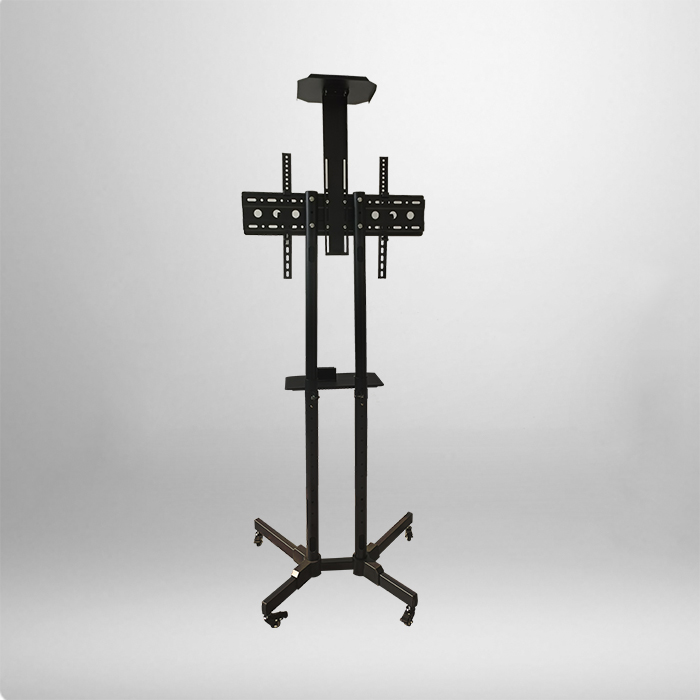
In diverse scenarios such as modern exhibitions, education, healthcare, corporate conferences, and event planning, the convenient deployment and flexible adjustment of audiovisual equipment are becoming increasingly important. As a professional mobile support device, the TV Stand Cart provides a stable, reliable, and freely movable solution for terminals such as televisions and displays, significantly improving space utilization efficiency and equipment convenience.
What is a TV stand cart?
>>>>>>A TV stand cart is a mobile stand that integrates a support base, column structure, equipment mounting plate (usually compliant with VESA standards), and caster system. It is designed for safe carrying and convenient mobile televisions, large displays, or interactive tablets, suitable for dynamic environments that require frequent adjustment of device positions or sharing of devices.
Core design elements and functional characteristics
A high-quality TV stand cart typically has the following key characteristics:
Stable load-bearing structure:
High strength frame: usually made of high-quality steel (such as cold-rolled steel) or aluminum alloy to ensure the overall structure is sturdy and durable.
Wide base: Provides low center of gravity and wide support surface, effectively preventing equipment from overturning.
VESA compatible mounting board: standardized mounting holes (such as 75x75mm, 100x100mm, 200x200mm, 400x400mm, etc.), compatible with the vast majority of televisions and monitors on the market.
Adjustable clamping/straps: Some models provide additional fixing devices to enhance the safety of the equipment during movement.
Flexible and efficient mobility:
High quality caster system: core components, typically including:
Locking casters: At least two casters are equipped with braking devices (foot brake or rotary brake) to ensure that the bracket is stable and does not slide after positioning.
Wanxiang Wheel: Provides 360 degree steering capability, enhancing handling flexibility.
Material selection: Hard polyurethane (PU) wheels are wear-resistant and quiet, suitable for indoor hard floors; Rubber wheels provide better shock absorption.
Smooth implementation experience: Optimized wheel bearing design and reasonable weight distribution ensure that a single person can easily push a fully loaded bracket.
Convenient cable management:
Avoiding tripping risks: Neat wiring not only looks beautiful, but also eliminates potential safety hazards during movement.
Humanized detail design:
Height adjustment (some models): Gas spring assisted or mechanical adjustment, allowing users to adjust the screen height within a certain range to meet different viewing needs.
Integrated storage platform/tray: The base often has a platform for placing media players (such as Apple TV, set-top boxes), mini computers, keyboards, mice, or file materials.
Handle design: convenient for users to grip and guide the movement of the cart.
Core application scenarios
The value of TV stand carts lies in their mobility and adaptability, and they are widely used in:
Education and Training: Shared smart TVs/interactive tablets between classrooms, supporting group teaching and mobile classrooms.
Enterprise office: flexible deployment of conference rooms for presentations and video conferences; Open the temporary collaboration station in the office area.
Healthcare: Entertainment and education for patients in the ward; Information display in the consultation room or operating room; Mobile ward inspection workstation.
Retail and Display: Product information display and promotional activities in shopping malls, exhibition halls, and trade shows.
Hotels and Meetings: Auxiliary display devices in banquet halls and conference rooms that can quickly adjust their positions according to the agenda.
Control room and monitoring center: serve as temporary or auxiliary mobile carriers for monitoring screens.
Key points for choosing a TV stand cart
To ensure safety, reliability, and meet usage requirements, attention should be paid to:
Load bearing capacity: the primary indicator. It must be greater than the maximum weight of the installed TV/monitor and leave a certain safety margin (recommended at least 20%).
compatibility:
VESA standard: Confirm whether the VESA hole spacing range of the bracket matches the installation hole position on the back of the device.
Screen size range: The bracket is usually labeled with the screen size range it is compatible with (such as 32 “-70”).
Wheel performance:
Reliability of locking mechanism: It must be stable after braking.
Ground adaptability: Choose the appropriate wheel material and type (such as carpet wheels with brakes) based on the use of the ground (smooth tiles, carpets, uneven ground).
Smooth movement and silence: affecting user experience.
Structural stability:
Material and process: High quality steel thickness, welding/connection point firmness.
Base size and weight: Larger bases are usually more stable.
Cable management: Whether the design is reasonable and can meet the required number and type of cables for the equipment.
Additional functional requirements: Do you need height adjustment, tilt adjustment, additional storage space, etc.
Safety certification: Compliance with relevant safety standards (such as EN 14471) is an important endorsement of product reliability.
Installation convenience: Whether the assembly of the bracket itself and the installation of the TV are convenient.
Summary of Advantages
Space layout liberalization: Breaking fixed installation restrictions and adjusting device positions anytime and anywhere according to needs.
Maximizing device sharing: One device can serve multiple spaces or scenarios, improving utilization.
Deployment efficiency improvement: Quickly complete device positioning or transfer, saving time and manpower.
Security and stability guarantee: Professional design ensures the safety of equipment in both static and mobile states.
Clean and beautiful environment: Excellent cable management keeps the environment clean and professional.
Investment return optimization: Reduce equipment duplicate purchase costs through sharing.
conclusion
The TV stand trolley is an ideal tool for managing and using large audiovisual equipment in modern dynamic environments. It liberates the television or monitor from a fixed position, giving the device unprecedented flexibility and functionality. A well-designed and reliable TV stand cart is an important assistant for improving space efficiency and workflow fluency.
Note: As a supplier specializing in the design and manufacturing of metal products, Gometal’s product line typically includes TV stand carts that meet different load-bearing and functional requirements. The design and production of such products strictly follow safety regulations and quality standards, committed to providing users with stable, durable, and convenient mobile display solutions. For specific product technical specifications and applicability, it is recommended to refer to the detailed technical information provided by the manufacturer.


